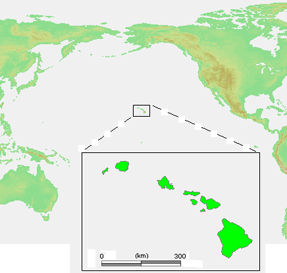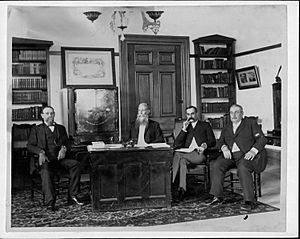Provisional Government of Hawaii facts for kids
Quick facts for kids
Provisional Government of Hawaii
Aupuni Kūikawā o Hawaiʻi (Hawaiian)
|
|||||||||
|---|---|---|---|---|---|---|---|---|---|
| 1893–1894 | |||||||||
 |
|||||||||
| Capital | Honolulu | ||||||||
| Common languages | Hawaiian, English | ||||||||
| Government | Provisional government | ||||||||
| Provisional Government | |||||||||
|
• 1893-1894
|
Committee of Safety | ||||||||
| Historical era | New Imperialism | ||||||||
| January 17 1893 | |||||||||
| 14 December 1893 - 11 January 1894 | |||||||||
| July 4 1894 | |||||||||
| Currency | Hawaiian dollar, U.S. dollar |
||||||||
|
|||||||||

The Provisional Government of Hawaii (P.G.) was a temporary government. It was set up after the Hawaiian Kingdom was overthrown on January 17, 1893. A group called the Committee of Safety led this change. Sanford B. Dole, a former judge, became its President. This new government replaced the Kingdom of Hawaii and its ruler, Queen Liliʻuokalani. The Provisional Government lasted until the Republic of Hawaii was created on July 4, 1894.
Contents
Setting Up the Government
After taking over the Hawaiian Kingdom, the new leaders quickly formed the Provisional Government. Their main goal was to have Hawaii join the United States. They sent a group, including Lorrin A. Thurston, to the U.S. to make a treaty. This treaty was sent to the U.S. Senate for approval by President Benjamin Harrison.
At the same time, Princess Victoria Kaʻiulani traveled to Washington D.C.. She spoke out against the overthrow, saying it was against the law.
U.S. President Cleveland's Actions
In March 1893, a new U.S. President, Grover Cleveland, took office. He did not support the idea of America taking over other lands. President Cleveland stopped the treaty and ordered an investigation. He wanted to know what really happened during the overthrow of the Hawaiian monarchy.
After getting a report in July, Cleveland said the U.S. had used its military illegally. He asked for Queen Liliʻuokalani to be put back in power. However, Sanford Dole, the leader of the Provisional Government, refused. President Cleveland then sent the issue to the U.S. Congress.
The U.S. Senate held its own investigation, called the Morgan Report. This report said that the U.S. had not been involved in the overthrow. Even after this, President Cleveland still believed the Provisional Government was not a true or legal government.
Hawaii's Military
After the monarchy was overthrown, a military force was created on January 27, 1893. It was led by Colonel John Harris Soper. This military had four groups of soldiers. Three were like a national guard, and one was a regular army company.
- A Company: Made of German volunteers.
- B Company: Made of members from the Honolulu Rifles.
- C Company: Made of Portuguese volunteers.
- D Company: Also from the Honolulu Rifles, these were the regular soldiers.
This military was active under the Provisional Government. They were called into action during the Leprosy War in 1893. They also fought during the 1895 Counter-Revolution when Hawaii was a republic. Later, when Hawaii became a U.S. territory in 1898, these companies joined the Army National Guard.
Life in Hawaii Under the New Government
Under the Provisional Government, rules became stricter. For example, Chinese immigrants were not allowed to become citizens. The Hawaii Department of Education also pushed for English to be the main language. This nearly caused the Hawaiian language to disappear.
The number of people allowed to vote also dropped greatly. Under the earlier Bayonet Constitution, about 14,000 people could vote. Now, only about 4,000 people could vote. Most of these were politicians already in power. At the time, Hawaii had about 100,000 people.
James Henderson Blount, who investigated the overthrow, wrote about this unfair voting system. He said that if the people were allowed to vote freely, they would not have chosen to join the U.S.
The Blount Investigation
The first main task for the Provisional Government was to set up a temporary government. This was while Lorrin A. Thurston was in Washington, D.C., trying to get Hawaii annexed by the U.S. Some people suggested that Princess Kaʻiulani should take power. They thought a group from the Committee of Safety could rule for her. But since the princess was not in Hawaii, this idea was quickly rejected.
The Provisional Government faced a big challenge when U.S. President Benjamin Harrison lost the election. President Harrison had supported Hawaii joining the U.S. The new president, Grover Cleveland, was against the idea of America taking over other countries. He immediately worked to stop the annexation treaty.
President Cleveland heard Princess Kaʻiulani's pleas for her aunt, Queen Liliʻuokalani. He then withdrew the treaty and started an investigation into what happened.
Cleveland chose James Henderson Blount to lead this investigation in Hawaii. Blount's main job was to find out how Queen Liliʻuokalani's government was overthrown. Blount's report concluded that John L. Stevens, the U.S. Minister to Hawaii, had helped the overthrow. Stevens had ordered U.S. troops from the USS Boston to land in Hawaii.
Based on Blount's report, Cleveland sent Albert Sydney Willis to Hawaii with secret instructions. Willis eventually got Queen Liliʻuokalani to promise to forgive those who overthrew her. After getting this promise, Willis officially demanded that the Provisional Government give up power and bring back the monarchy. However, by then, President Cleveland had already sent the matter to Congress.
On December 23, 1893, Sanford B. Dole, the leader of the Provisional Government, refused Willis's demand. He plainly said they would not give power back to the Queen.
The Morgan Investigation
Because President Cleveland sent the issue to Congress, the Senate decided to hold its own hearings. They wanted to investigate U.S. involvement in the overthrow. They also wanted to see if President Cleveland had the right to appoint Blount without Senate approval. Senator John Tyler Morgan, who supported Hawaii joining the U.S., led this investigation.
The Morgan Report disagreed with Blount's findings and President Cleveland's views. It was submitted on February 26, 1894. The report concluded that U.S. troops had stayed completely neutral during the overthrow. It also cleared Minister Stevens of any wrongdoing for landing troops. The report said that Blount's appointment and investigation were constitutional, even without Congress's approval. However, the nine senators on the committee could not agree on a final conclusion. Only Senator Morgan signed the main summary of the report.
After the Morgan Report and a resolution from Congress on May 31, 1894, President Cleveland officially said the Provisional Government was "neither de jure nor de facto." This meant it was not a legal government, nor was it a government that truly held power.
On February 7, 1894, the U.S. House of Representatives passed a resolution. It stated that the U.S. minister's actions in helping to overthrow Hawaii's government were wrong. It also said that the U.S. should not interfere in other countries' affairs. The resolution added that Hawaii should be free and independent. It also said that the U.S. should not annex Hawaii or take control of it.
The Republic of Hawaii
After the Morgan Report and the U.S. policy of non-interference, Lorrin A. Thurston and the Provisional Government of Hawaii held a meeting. They created a new government called the Republic of Hawaii. This government stayed in power until the U.S. officially took over Hawaii in 1898 with the Newlands Resolution.
See also
 In Spanish: Gobierno provisional de Hawái para niños
In Spanish: Gobierno provisional de Hawái para niños


